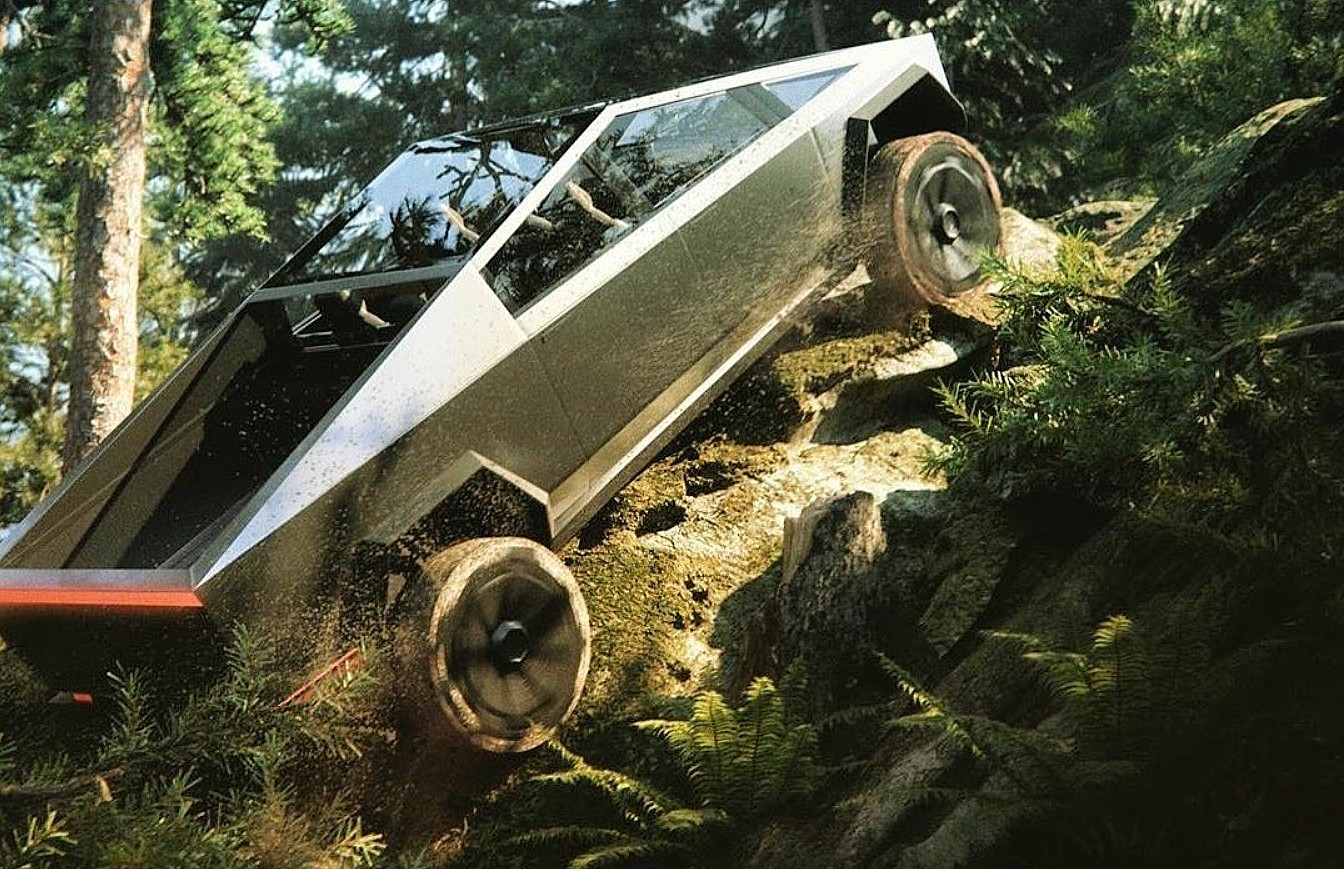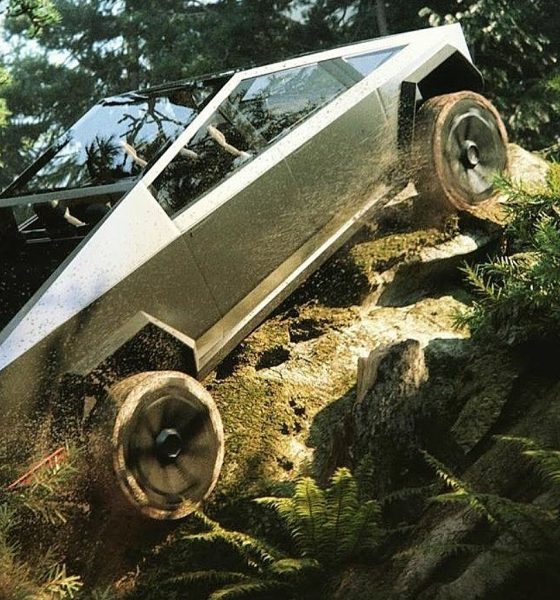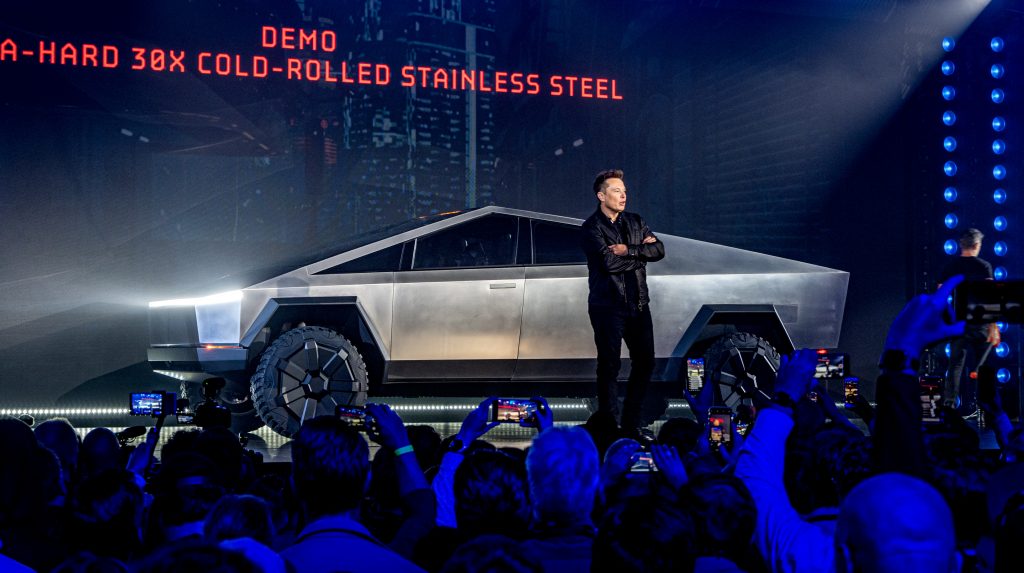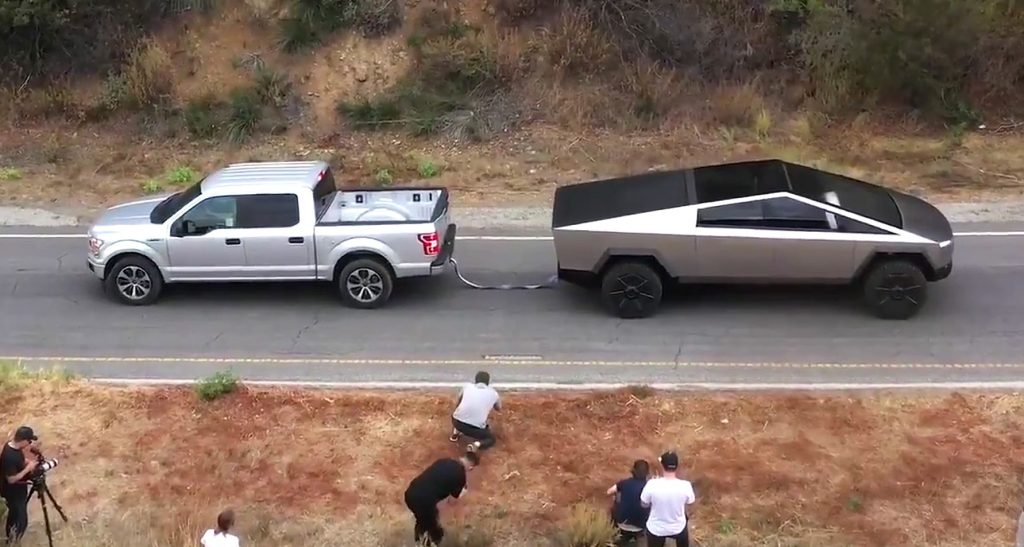

News
Tesla’s Giga Texas completely solves the Cybertruck’s ‘Cowboy Problem’
Yesterday, Elon Musk posted a cryptic tweet asking the Twitterverse about the possibility of Tesla establishing a Giga Texas facility. The response was overwhelmingly positive, despite some Tesla supporters questioning the rationale behind the notion of investing in a state that has been practically hostile to the company. Yet Tesla’s upcoming lineup of vehicles, particularly its Cybertruck, the addition of Giga Texas to the company’s growing list of factories may very well be a godsend. It could, for one, address the Cybertruck’s “Cowboy Problem” in Texas.
Texas is a large market for pickup trucks. Pickups are so popular in the Lone Star state that the automotive auctioneering firm Mecum did not even bother including sedans and other cars in its auction in Houston last year. Texas accounts for about one of every six pickups sold in the United States. Considering that trucks are among the most popular vehicles in the country, this number is very substantial. This is a goldmine that disruptive all-electric companies like Tesla can tap into, provided their vehicles are embraced by consumers.
In a recent article, author David Freedman noted that real truck buyers primarily worship a vehicle’s specs and utility when considering their next purchase. This is the reason why workhorses such as the Ford F-150 have become such a juggernaut in the United States auto market, and in Texas in particular. Former GM executive Tony Posawatz, who was behind the Chevy Volt, highlighted this in a statement. “Truck buyers are more sophisticated than car buyers in what they’re looking for. They look at their truck as a tool,” he said.

Tesla and its Cybertruck team appear to be fully aware of this, as evidenced by the vehicle’s features and specs, many of which seemed to have been included following CEO Elon Musk’s brainstorming session with his followers on Twitter. From hauling capacity to sheer unadulterated power, the Cybertruck has it all. The vehicle even offers a range of over 500 miles per charge in its sub-$70,000 configuration, something that is yet to be matched by other upcoming EV truck makers like Rivian. The Cybertruck is designed to take an immense amount of punishment without flinching as well, thanks to its stainless steel exoskeleton.
Its controversial looks aside, the Cybertruck objectively has the features and specs that can make it a massive disruptor in the EV segment. Yet there are psychological barriers that work against the vehicle’s favor, and one of them may very well be Tesla’s reputation as a California-bred, Silicon Valley-based company that makes sleek, futuristic cars. Simply put, Tesla does not have the reputation of a car maker that can produce tough vehicles for work. Ford, GM, and other veteran automakers do, and they could be counting on this for their own upcoming electric trucks.
Gabriel Smart of Planet Ford in Houston, which primarily sells trucks, describes the automaker’s pitch for its F-150. “When someone comes in for a Ford truck, it’s because that’s what their buddy drives, it’s what their dad drives, it’s what their granddad drives. So that’s what they want to drive, too,” he said. Tesla, then, has a challenge ahead of it. The company would not only have to buck the stereotypes of electric vehicles with the Cybertruck; it would also have to prove to dedicated truck buyers that its all-electric pickup is a serious alternative to tried and tested vehicles such as the F-150.

One of the ways that the company can do this is to simply make the Cybertruck as the de facto electric vehicle of Texas by producing the truck right in the state itself. If Giga Texas does pan out, and if the facility ends up producing vehicles like the Cybertruck, it would be very difficult for Texas’ regulators and truck buyers to not support the vehicle. The Cybertruck is already compelling enough with its specs, features, and price alone. Add the fact that it is built using American labor at the heart of pickup country, and the vehicle may very well become the symbol of the US’ next-generation of trucking. This, ultimately, solves any possible “Cowboy Problem” Tesla may have with its all-electric pickup, and it may open up the state to more of the company’s vehicles as well.
Elon Musk noted during the fourth-quarter earnings call that the demand for the Cybertruck has been impressive so far, with the company getting enough orders to correspond to several years’ worth of production. “I have never seen actually such a level of demand as this — we’ve never seen anything like it basically. I think we will make as many as we can sell for many years. So — as many — we’ll sell as many as we can make, it’s going to be pretty nuts,” Musk said. And this is all before the Cybertruck can even tap into the heart of the US’ pickup market.
The Cybertruck is expected to enter the market next year. Tesla plans to start with the tri-motor AWD and dual motor AWD. The $39,990 single motor RWD Cybertruck, which undercuts competitors such as the Rivian R1T, is expected to start production in late 2022.

News
Tesla hints at Starlink integration with recent patent
“By employing polymer blends, some examples enable RF transmission from all the modules to satellites and other communication devices both inside and outside the vehicle.”

Tesla hinted at a potential Starlink internet terminal integration within its vehicles in a recent patent, which describes a vehicle roof assembly with integrated radio frequency (RF) transparency.
The patent, which is Pub. No U.S. 2025/0368267 describes a new vehicle roof that is made of RF-transparent polymer materials, allowing and “facilitating clear communication with external devices and satellites.”
Tesla believes that a new vehicle roof design, comprised of different materials than the standard metallic or glass elements used in cars today, would allow the company to integrate modern vehicular technologies, “particularly those requiring radio frequency transmission and reception.
Tesla has recently filed a US patent application on integrating RF transparent materials into the roof structure.
“facilitating clear communication with external devices and satellites”
Tesla fleet is getting @Starlink connectivity integration soon. LFG @Tesla @elonmusk… pic.twitter.com/bLa8YtPLd1
— Chansoo Byeon (@Chansoo) December 9, 2025
Instead of glass or metallic materials, Tesla says vehicles may benefit from high-strength polymer blends, such as Polycarbonate, Acrylonitrile Butadiene Styrene, or Acrylonitrile Styrene Acrylate.
These materials still provide ideal strength metrics for crashworthiness, stiffness for noise, vibration, and harshness control, and are compliant with head impact regulations.
They would also enable better performance with modern technologies, like internet terminals, which need an uninterrupted signal to satellites for maximum reception. Tesla writes in the patent:
“By employing polymer blends, some examples enable RF transmission from all the modules to satellites and other communication devices both inside and outside the vehicle.”

One of the challenges Tesla seems to be aware of with this type of roof design is the fact that it will still have to enable safety and keep that at the forefront of the design. As you can see in the illustration above, Tesla plans to use four layers to increase safety and rigidity, while also combating noise and vibration.
It notes in the patent that disclosed examples still meet the safety requirements outlined in the Federal Motor Vehicle Safety Standards (FMVSS).
Starlink integrated directly into Tesla vehicles would be a considerable advantage for owners. It would come with a handful of distinct advantages.
Initially, the inclusion of Starlink would completely eliminate cellular dead zones, something that is an issue, especially in rural areas. Starlink would provide connectivity in these remote regions and would ensure uninterrupted service during road trips and off-grid adventures.
It could also be a critical addition for Robotaxi, as it is crucial to have solid and reliable connectivity for remote monitoring and fleet management.
Starlink’s growing constellation, thanks to SpaceX’s routine and frequent launch schedule, will provide secure, stable, and reliable internet connectivity for Tesla vehicles.
Although many owners have already mounted Starlink Mini dishes under their glass roofs for a similar experience, it may be integrated directly into Teslas in the coming years, either as an upgrade or a standard feature.
News
Tesla supplements Holiday Update by sneaking in new Full Self-Driving version
It seems Tesla was waiting for the Hardware 4 rollout, as it wanted to also deploy a new Full Self-Driving version to those owners, as it appeared in the release notes for the Holiday Update last night.

Tesla has surprised some owners by sneaking in a new Full Self-Driving version with the wide release of the Holiday Update, which started rolling out to Hardware 4 owners on Friday night.
Tesla has issued a controlled and very slow release pattern with the Holiday Update, which rolls out with Software Version 2025.44.25.5.
For the past two weeks, as it has rolled out to Hardware 3 and older Tesla owners, the company has kept its deployment of the new Software Version relatively controlled.
It seems Tesla was waiting for the Hardware 4 rollout, as it wanted to also deploy a new Full Self-Driving version to those owners, as it appeared in the release notes for the Holiday Update last night.
Tesla Full Self-Driving v14.2.1.25 made its first appearance last night to Hardware 4 owners who are members of the Early Access Program (EAP). It appears to be a slight refinement from FSD v14.2.1, which has been out for a couple of weeks.
Tesla v2025.44.25.5 Holiday update incoming
Also Full Self-Driving v14.2.1.25!!! pic.twitter.com/74D7S0UGXz
— TESLARATI (@Teslarati) December 13, 2025
Many owners welcome the new FSD version, us included, because we’ve been less than impressed with v14.2.1. We have experienced some minor regressions with v14.2.1, especially with Speed Limit recognition, Speed Profile tinkering, and parking performance.
As it stands, Full Self-Driving is still particularly impressive, but Tesla is evidently having an issue with some of the adjustments, as it is still refining some of the performance aspects of the suite. This is expected and normal with some updates, as not all of them are an improvement in all areas; we routinely see some things backtrack every once in a while.
This new FSD version is likely to take care of those things, but it also includes all of the awesome Holiday Update features, which include:
- Grok with Navigation Commands (Beta) – Grok will now add and edit destinations.
- Tesla Photobooth – Take pictures inside your car using the cabin-facing camera
- Dog Mode Live Activity – Check on your four-legged friend on your phone through periodic snapshots taken of the cabin
- Dashcam Viewer Update – Includes new metrics, like steering wheel angle, speed, and more
- Santa Mode – New graphics, trees, and a lock chime
- Light Show Update – Addition of Jingle Rush light show
- Custom Wraps and License Plates – Colorizer now allows you to customize your vehicle even further, with custom patterns, license plates, and tint
- Navigation Improvements – Easier layout and setup
- Supercharger Site Map – Starting at 18 pilot locations, a 3D view of the Supercharger you’re visiting will be available
- Automatic Carpool Lane Routing – Navigation will utilize carpool lanes if enabled
- Phone Left Behind Chime – Your car will now tell you if you left a phone inside
- Charge Limit Per Location – Set a charge limit for each location
- ISS Docking Simulator – New game
- Additional Improvements – Turn off wireless charging pad, Spotify improvements, Rainbow Rave Cave, Lock Sound TRON addition
Tesla also added two other things that were undocumented, like Charging Passport and information on USB drive storage to help with Dashcam.
Cybertruck
Tesla updates Cybertruck owners about key Powershare feature

Tesla is updating Cybertruck owners on its timeline of a massive feature that has yet to ship: Powershare with Powerwall.
Powershare is a bidirectional charging feature exclusive to Cybertruck, which allows the vehicle’s battery to act as a portable power source for homes, appliances, tools, other EVs, and more. It was announced in late 2023 as part of Tesla’s push into vehicle-to-everything energy sharing, and acting as a giant portable charger is the main advantage, as it can provide backup power during outages.
Cybertruck’s Powershare system supports both vehicle-to-load (V2L) and vehicle-to-home (V2H), making it flexible and well-rounded for a variety of applications.
However, even though the feature was promised with Cybertruck, it has yet to be shipped to vehicles. Tesla communicated with owners through email recently regarding Powershare with Powerwall, which essentially has the pickup act as an extended battery.
Powerwall discharge would be prioritized before tapping into the truck’s larger pack.
However, Tesla is still working on getting the feature out to owners, an email said:
“We’re writing to let you know that the Powershare with Powerwall feature is still in development and is now scheduled for release in mid-2026.
This new release date gives us additional time to design and test this feature, ensuring its ability to communicate and optimize energy sharing between your vehicle and many configurations and generations of Powerwall. We are also using this time to develop additional Powershare features that will help us continue to accelerate the world’s transition to sustainable energy.”
Owners have expressed some real disappointment in Tesla’s continuous delays in releasing the feature, as it was expected to be released by late 2024, but now has been pushed back several times to mid-2026, according to the email.
Foundation Series Cybertruck buyers paid extra, expecting the feature to be rolled out with their vehicle upon pickup.
Cybertruck’s Lead Engineer, Wes Morrill, even commented on the holdup:
As a Cybertruck owner who also has Powerwall, I empathize with the disappointed comments.
To their credit, the team has delivered powershare functionality to Cybertruck customers who otherwise have no backup with development of the powershare gateway. As well as those with solar…
— Wes (@wmorrill3) December 12, 2025
He said that “it turned out to be much harder than anticipated to make powershare work seamlessly with existing Powerwalls through existing wall connectors. Two grid-forming devices need to negotiate who will form and who will follow, depending on the state of charge of each, and they need to do this without a network and through multiple generations of hardware, and test and validate this process through rigorous certifications to ensure grid safety.”
It’s nice to see the transparency, but it is justified for some Cybertruck owners to feel like they’ve been bait-and-switched.








